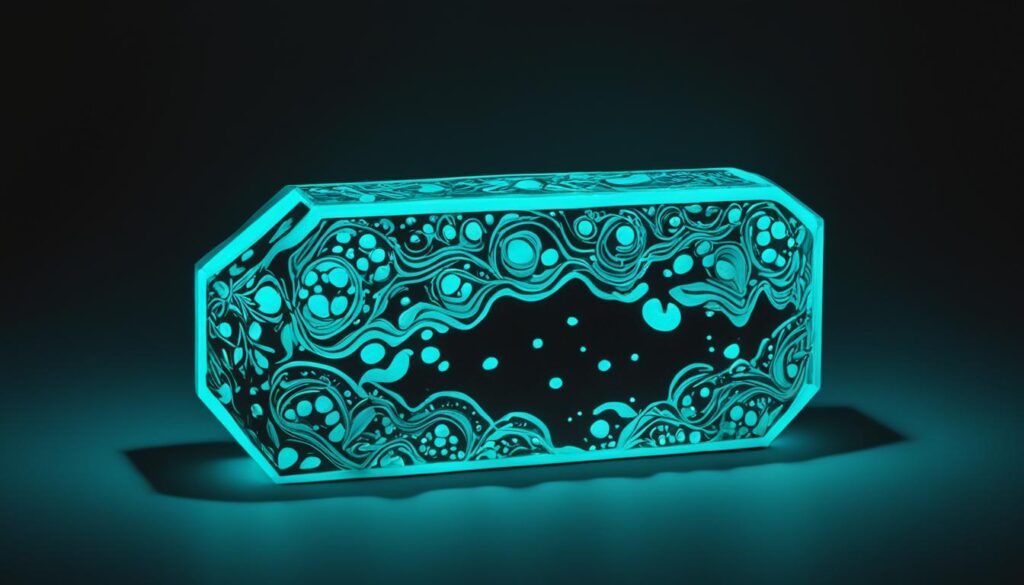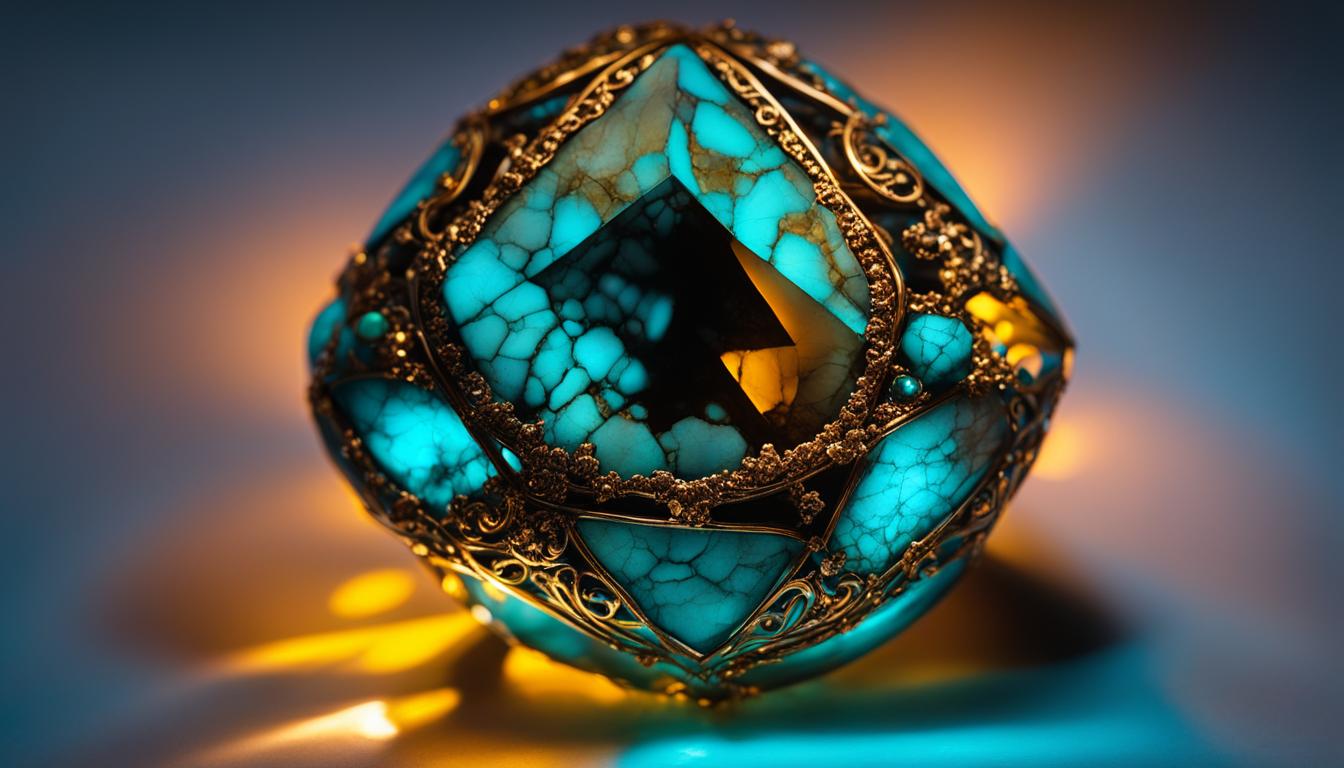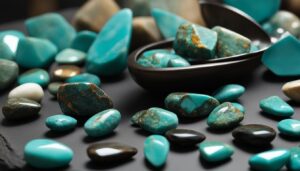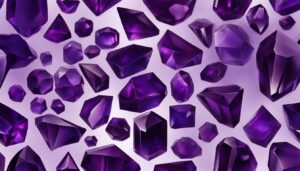Turquoise, with its stunning blue-green hue, has captivated many with its beauty. One intriguing question that often arises is whether turquoise exhibits a glowing reaction under blacklight. In this article, we will delve into the world of turquoise and blacklight to determine if this beloved gemstone truly glows in the dark.
Understanding the interaction between turquoise and blacklight can shed light on the unique properties of this gemstone. We’ll explore the composition of turquoise and how it plays a role in its reaction to different lighting conditions. Additionally, we’ll take a closer look at the fascinating world of gemstone luminescence and how it applies to turquoise.
Key Takeaways:
- Turquoise may exhibit a glowing reaction under blacklight or UV light, but the intensity and presence of the effect can vary.
- Genuine turquoise is generally more expensive than imitations, and various tests can help in identifying real turquoise.
- Gemstone luminescence, including turquoise’s interaction with UV light, adds to the allure and fascination of these beautiful gemstones.
- The composition of turquoise, which includes copper, aluminum, and phosphate, contributes to its unique properties.
- Understanding how different gemstones react to various lighting conditions can aid in gemstone identification.
The Composition of Turquoise
Turquoise, a captivating gemstone, is a hydrous phosphate mineral that belongs to the family of phosphate minerals. Its composition consists of copper, aluminum, and phosphate, creating a unique blend that gives turquoise its distinctive blue-green hue. This stunning gemstone is hailed for its striking color, which can vary from a delicate light blue to a rich deep green. The composition of turquoise plays a significant role in determining its properties, including its reactions to different lighting conditions.
| Color | Hardness on Mohs Scale | Transparency |
|---|---|---|
| Blue-green to green | 5.5-6 | Opaque to translucent |
The Interaction Between Turquoise and Blacklight
When exposed to blacklight or ultraviolet (UV) light, turquoise may exhibit fluorescence or luminescence. Fluorescence refers to the immediate emission of light by a substance when it absorbs UV radiation. On the other hand, luminescence involves the delayed emission of light after the removal of the energy source. Turquoise may exhibit either of these reactions under blacklight, depending on factors such as its composition and impurities.
“The turquoise stone can truly come to life under blacklight or UV light. It’s fascinating to witness how it reacts and emits light, showcasing its unique properties.” – Gemstone Expert
To fully understand the interaction between turquoise and blacklight, let’s delve deeper into each specific reaction:
Turquoise Fluorescence
Under blacklight or UV light, some turquoise specimens may emit a fluorescent glow. This occurs when the turquoise absorbs UV radiation and immediately re-emits the energy as visible light. The fluorescence can intensify the turquoise’s color, adding a vibrant glow that enchants the viewer.
Turquoise Luminescence
Another possible reaction is luminescence. While fluorescence is an immediate response, luminescence involves the delayed emission of light. In the case of turquoise, this delayed glow can persist even after removing the UV light source, creating an enchanting luminescent effect.
It’s important to note that the intensity and extent of the turquoise’s blacklight reaction may vary depending on several factors. The composition of the turquoise, including the presence of impurities, can influence the strength of fluorescence or luminescence. Additionally, the specific lighting conditions and the wavelength of the UV light used can also impact the turquoise’s reaction.
To visually showcase the turquoise’s blacklight reaction, here is an image depicting a magnificent turquoise stone under UV light:

As you can see, the turquoise exhibits a captivating glow when exposed to UV light, highlighting its mesmerizing luminescent properties.
| Blacklight Reaction | Description |
|---|---|
| Fluorescence | Immediate emission of light when turquoise absorbs UV radiation, intensifying its color and creating a vibrant glow. |
| Luminescence | Delayed emission of light, even after removing the UV light source, resulting in a mesmerizing and enchanting glow. |
Identifying Genuine Turquoise and Fake Turquoise
Distinguishing between genuine turquoise and fake turquoise can be challenging, as fake turquoise can closely resemble the real stone. When investing in turquoise jewelry or gemstones, it is crucial to ensure the authenticity of the turquoise. Here are some key factors to consider when identifying real turquoise:
- Price: Genuine turquoise is generally more expensive than imitations. If a piece of turquoise jewelry seems remarkably affordable, it is likely to be fake.
- Appearance: Genuine turquoise exhibits a range of shades, from light blue to deep green, with natural variation and sometimes subtle matrix patterns. Fake turquoise may appear too perfect or have a uniform color.
- Weight: Real turquoise feels heavier compared to its size, while fake turquoise can sometimes be lighter due to the use of substitute materials.
Visual assessments alone may not always be conclusive due to the various techniques used to create fake turquoise. To further verify the authenticity, other tests can be performed:
- Scratch Test: Genuine turquoise is relatively resistant to scratches, so gently scratching the surface of the stone with a pin or a knife can help determine its authenticity. If the stone easily scratches or chips, it is likely fake.
- Heating Test: Applying heat to turquoise can help identify fake turquoise. Genuine turquoise will not change color when exposed to heat, while fake turquoise may exhibit color alteration.
- Professional Evaluation: If in doubt, seek the opinion of a reputable gemologist or jeweler who specializes in turquoise. They have the expertise and tools to accurately determine the authenticity of the stone.
By considering these factors and performing appropriate tests, you can improve your ability to identify genuine turquoise and avoid being deceived by imitations.

“Distinguishing between genuine turquoise and fake turquoise can be challenging, as fake turquoise can closely resemble the real stone.” – Gemstone Expert
The Fascinating World of Gemstone Luminescence
Gemstone luminescence is a captivating phenomenon that occurs when certain minerals absorb and emit light energy. It serves as a valuable tool for gemologists in differentiating between natural and synthetic gems, while also intriguing collectors with its unique beauty. Luminescence can be categorized into two main types: fluorescence and phosphorescence.
“Gemstone luminescence is like nature’s hidden light show, revealing the mesmerizing glow of these precious stones under the right conditions.”
Fluorescence refers to the immediate emission of light by a gemstone when it absorbs ultraviolet (UV) light. This interaction creates a vibrant display of color that is visible to the naked eye. Many gemstones, such as diamonds and rubies, exhibit fluorescence under UV light, showcasing stunning hues that enhance their overall allure.
Phosphorescence, on the other hand, involves the delayed emission of light after the energy source is removed. This means that even when the UV light is no longer present, the gemstone continues to emit light for a period of time. Phosphorescent gemstones, like some types of opals and spinels, create a radiant glow that lingers even in the dark.
The Glow Under UV Light
UV light is commonly used to trigger gemstone luminescence due to its high energy wavelength. When a gemstone absorbs UV light, the electrons within its atomic structure become excited and move to higher energy levels. As these electrons return to their original positions, they release energy in the form of visible light, resulting in the gemstone’s glowing effect.
The specific characteristics of gemstone luminescence can vary depending on the mineral’s composition and impurities. Some gemstones exhibit a vibrant and intense glow under UV light, while others may have a more subtle or even non-existent luminescent reaction. This uniqueness plays a crucial role in gemstone identification and can help distinguish between natural and synthetic stones.
Advancing Gemstone Identification
Gemstone luminescence has revolutionized the field of gemstone identification. By examining a gemstone’s reaction to UV light, gemologists can gather valuable information about its authenticity and origin. This knowledge is particularly essential when dealing with rare and valuable gemstones, ensuring that buyers and collectors are making informed decisions.
Furthermore, gemstone luminescence provides opportunities for further research and exploration. Scientists continue to study and discover new insights about the intricacies of gemstone luminescence, expanding our understanding of these marvelous natural wonders.
| Gemstone | Fluorescence | Phosphorescence |
|---|---|---|
| Opal | Varies – some exhibit strong fluorescence | Varies – some exhibit weak to moderate phosphorescence |
| Emerald | Varies – some exhibit weak fluorescence | No significant phosphorescence |
| Diamond | Varies – some exhibit strong fluorescence | No significant phosphorescence |
In summary, gemstone luminescence reveals the hidden beauty and secrets of these remarkable minerals. Fluorescence and phosphorescence bring gemstones to life under UV light, captivating viewers with their vibrant glows. With ongoing research and advancements in gemstone identification, the world of gemstone luminescence continues to unveil fascinating discoveries for gemologists, collectors, and enthusiasts alike.
Understanding Gemstone Luminescence and Turquoise
When it comes to turquoise, its luminescent properties can be truly captivating. The interaction between turquoise and UV light can result in fluorescence or phosphorescence, adding an enchanting glow to this already mesmerizing gemstone. Some specimens of turquoise may even exhibit a vivid glowing response under UV light, enhancing their inherent beauty and allure.
The extent and intensity of the luminescent effect, however, can vary depending on various factors. One such factor is the composition of the turquoise itself. The unique combination of copper, aluminum, and phosphate in turquoise plays a significant role in determining its luminescent properties. Additionally, the presence of impurities in the stone can also influence the intensity and color of the glowing effect.
The ability of turquoise to interact with UV light adds to its overall appeal and uniqueness, making it a sought-after gemstone for jewelry and decorative purposes. Whether it’s the vibrant fluorescence that immediately catches the eye or the captivating phosphorescence that lingers even after the UV light source is removed, turquoise’s luminescence is a testament to the beauty and wonder of the natural world.
Take a closer look at the stunning luminescence of turquoise under UV light:
Conclusion
In conclusion, the luminescent properties of turquoise shed light on the question of whether it glows in blacklight. While turquoise can exhibit fluorescence or phosphorescence when exposed to UV light, the intensity and presence of the glowing effect may vary. To identify genuine turquoise and distinguish it from fake counterparts, careful examination and testing are necessary. By understanding gemstone luminescence, including turquoise’s interaction with UV light, we can further appreciate the allure and fascination of these exquisite gemstones. Whether you’re a gemstone enthusiast or simply captivated by the beauty of turquoise, knowing how it reacts to blacklight adds an enchanting dimension to your experience.
FAQ
Does turquoise glow in blacklight?
Turquoise may exhibit fluorescence or luminescence under blacklight or ultraviolet light (UV). Its reaction to blacklight can vary depending on factors such as its composition and impurities.
What is turquoise composed of?
Turquoise is a hydrous phosphate mineral composed of copper, aluminum, and phosphate. Its unique combination of elements gives it its distinct blue-green hue.
How does turquoise interact with blacklight?
Turquoise may exhibit fluorescence or phosphorescence when exposed to blacklight or UV light. The extent and intensity of the luminescent effect can vary depending on factors such as composition and impurities.
How can you identify genuine turquoise from fake turquoise?
Differentiating between genuine and fake turquoise can be challenging. Price, appearance, weight, and various tests, such as the scratch test, can provide clues to identify genuine turquoise.
What is gemstone luminescence?
Gemstone luminescence is the phenomenon where certain minerals absorb and emit light energy. It can help differentiate between natural and synthetic gems and serves as a point of interest for collectors.
How does turquoise interact with gemstone luminescence?
Turquoise’s reaction to gemstone luminescence can result in fluorescence or phosphorescence. The presence of impurities and the specific composition of the turquoise can influence the extent and intensity of the glowing effect.
Are there any glowing properties of turquoise under blacklight?
Turquoise may exhibit fluorescence or phosphorescence under blacklight or UV light. However, the intensity and presence of the glowing effect can vary depending on factors such as composition and impurities.




